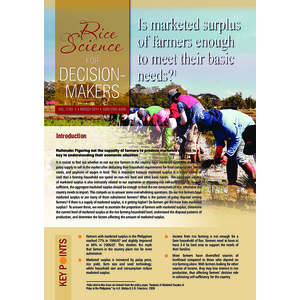Is marketed surplus of farmers enough to meet their basic needs?: Rice Science for Decision-Makers
Authors: Philippine Rice Research Institute
Policy Briefers
Description
It is crucial to find out whether or not our rice farmers in the country have marketed surplus or the excess palay supply to sell to the market after deducting their household requirements for food consumption, feeds, seeds, and payment of wages in kind. This is important because marketed surplus is a major source of cash that a farming household can spend on non-rice food and other basic needs. The aggregate volume of marketed surplus is also intricately related to our aspiration at attaining rice self-sufficiency. To be self-sufficient, the aggregate marketed surplus should be enough to feed the net consumers of rice; otherwise the country needs to import. This compels us to answer some overwhelming questions: Do our rice farmers have marketed surplus or are many of them subsistence farmers? What is the pattern of palay disposal among farmers? If there is a supply of marketed surplus, is it getting higher? Do farmers get the most from marketed surplus? To answer these, we need to ascertain the proportion of farmers with marketed surplus; determine the current level of marketed surplus at the rice farming household level; understand the disposal patterns of production; and determine the factors affecting the amount of marketed surplus.
Details
- Year Published: 2011
- ISBN: 2094-8409
- Pages: 4